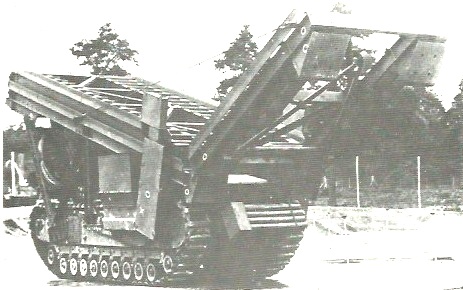The Churchill Great Eastern was a WWII rocket operated ramp tank designed to overcome obstacles which cannot could be bridged by the then in service Churchill ARK. It was able to form a bridge 60 feet (18m) long and could climb over a wall 12 feet (3.7m) high and 5 feet (1.5m) wide. The ramp was extended by firing two groups of 3″ rockets. The tank would stop at a canal, wall or any obstacle. Then the crew turning a windlass extends a distance-measuring device so that the correct position of the vehicle could be determined. When in the proper position, the rockets were fired causing the ramps to unfold and be thrown over the obstacle. Within seconds, the following vehicles could move up the rear ramp, over the bridging tank itself and then over the forward unfolded ramp. Recovering the ramp took longer and more effort which required an A-frame and a series of maneuvers to refold the ramps.


Cecil Vandepeer Clarke (1897–1961) was the engineer who designed and developed the Great Eastern. He also designed the Limpet mine and the Spigot gun The development work was done at the government department known as MD1 at Whitechurch in early 1944. Due to war needs, the department had some difficulty obtaining two Churchill tanks and the large amount of steel that was required. At the first live trial, the rockets were too powerful that they lifted the tank chassis along with the flying ramp where the driver had an unexpected rough ride but the trial continued and the viability of the design was confirmed. The prototype was built on a Churchill Mk I hull and after the successful initial trials ten more were built using the Churchill Mk IV chassis with heavier Mk VII suspension units fitted to handle the 48 ton weight.

After D-Day, Clarke and the ten Great Easterns were sent to France where Clarke demonstrated and trained the Canadians of the 21st Army Group who at the time were advancing in the Netherlands. As he hoped they were to be used to cross canals. They were planned to be used in an operation at the end of April 1945 but the Germans had surrendered in Holland and the operation was cancelled. So the Great Eastern was never used in combat.

Two vehicles were delivered to the 79th Armoured Division in early 1945. This Great Eastern of the 30th Armoured Brigade is seen in Deventer, Holand at the end of the war. Note the two heads peering over the top of the ramp.

Today at the Canadian War Museum, Ottawa
Great Eastern Ramp – Part A Video
Great Eastern Ramp – Part B Video
Another Great Eastern Ramp Video
